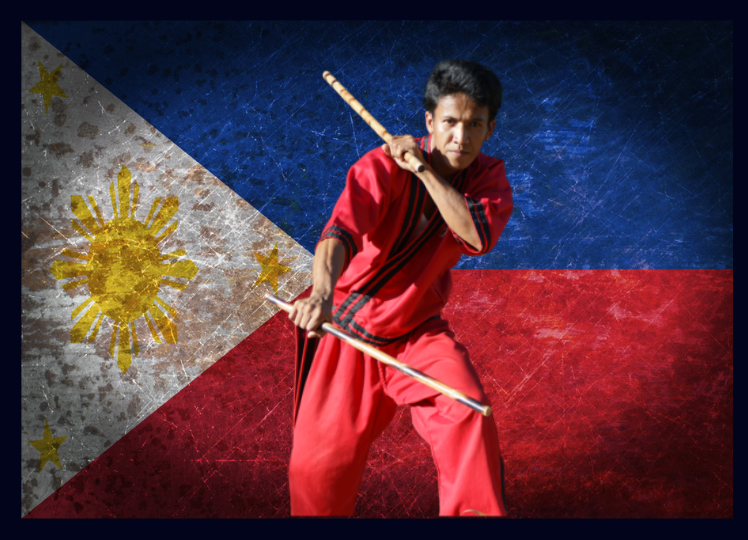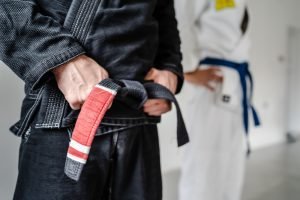This post dives into Arnis, the fast and fluid Filipino martial art of sticks, blades, and hand-to-hand combat—honed through generations for battlefield and self-defence mastery.
Table of Contents
The Deadly History of the Philippines
Arnis, (aka Kali or Eskrima/Escrima), is the national martial art of the Philippines. The three names are roughly interchangeable terms for the traditional Filipino Martial Arts (FMA). Arnis is characterized by weapon-based fighting with sticks, knives, bladed weapons, and various improvised weapons. However, it also incorporates unarmed techniques including striking, joint lock, grappling, and weapon disarming elements. The origin of Arnis is heavily intertwined with Filipino history and the different cultures of various tribes on the islands. Arnis practitioners are famous for their lightning-fast movements, efficient footwork, weapons proficiency, and vicious unarmed techniques. Much of its lethal reputation stems from the Island chain’s bloody history.
Arnis? Escrima or Kali? I'm confused...
Arnis is known by various names depending on where you are in the Philippines. Certain names are preferred in different regions of the Islands. The name Arnis comes from a Spanish word meaning ‘armor’ predominantly used in the northern parts of the Philippines. Escrima/eskrima, from the Spanish term esgrima meaning ‘fencing’ (Central Philippines). The term Kali is possibly derived from Kalis, the pre-Hispanic Filipino term for blades and fencing (Southern Philippines). All three are interchangeable terms for Filipino martial arts (FMA). For the purposes of simplicity, we will refer to the art as Arnis or FMA in this post.

A Brief History of FMA
The origin of Arnis can be traced back to indigenous Filipino fighting systems developed over centuries. These systems were shaped by tribal warfare, foreign influences, and the need for self-preservation in a land frequently contested by raiders, invaders, and colonizers.
While Arnis is now recognized as a weapons-based martial art, its roots extend beyond stick and blade combat. Early Filipino warriors were trained in hand-to-hand techniques, grappling, striking, joint manipulation, and improvised weapons, adapting their skills to both warfare and survival.
Due to the Philippines’ strategic location as a trading hub, Arnis absorbed influences from neighboring martial arts, including Silat (from the Malay Archipelago), Indian, Chinese, and Arab fighting systems. Later, Spanish fencing techniques were introduced during colonial rule, blending with native combat styles to create a unique hybrid system.
I'm a fighter not a writer!
One of the problems with tracing Arnis’ history was that actual records of the early techniques and styles don’t exist. Like many ancient peoples, the Filipinos tribes had an oral tradition, where knowledge was passed between master and student informally. This made attempts to trace an actual lineage of origins, practitioners, and influences very difficult. Most records of Arnis exist only from after the Spaniards arrived in the Philippines. The first recorded use of Arnis was when the Spanish were fought off by native islanders when they tried to invade. Thanks to the efforts of Filipino martial artists and historians, some degree of a timeline has been achieved over time.
Evolution and Endurance
Despite centuries of foreign occupation and attempts to suppress its practice, Filipino warriors continued to refine and evolve Arnis, keeping it alive through underground training, theatrical performances, and battlefield applications.
From resisting Spanish conquistadors and American troops to fighting in World War II guerrilla warfare, Arnis has proven itself as a practical, adaptable, and deadly combat art. Today, it is not only a symbol of Filipino identity and resilience but also a globally respected martial art, used in sport, self-defense, and military training worldwide.
For more on the history of FMA, click on the link below
Modern History
In 1966 Remy Presas began developing his system which he called ‘Modern Arnis’. Remy had trained in the Filipino arts since the age of six and had been involved in numerous escrima duels. He had also studied Judo and Karate extensively. Remy began identifying the basic concepts of the numerous systems he had learned and merging them into Modern Arnis. His goal was to create a well-rounded and effective self-defense system. One that was injury-free (Arnis training was notoriously brutal before this) and that preserved the older Arnis systems traditions.
Alongside his foundation styles, Remy continued to research and study other Filipino systems and traditions. He was particularly interested in Balintawak Eskrima. His desire to reinvigorate interest in his country’s traditional martial art. He continued to make modifications and improvements to what he had learned. Unfortunately, political considerations eventually forced him to relocate to North America.

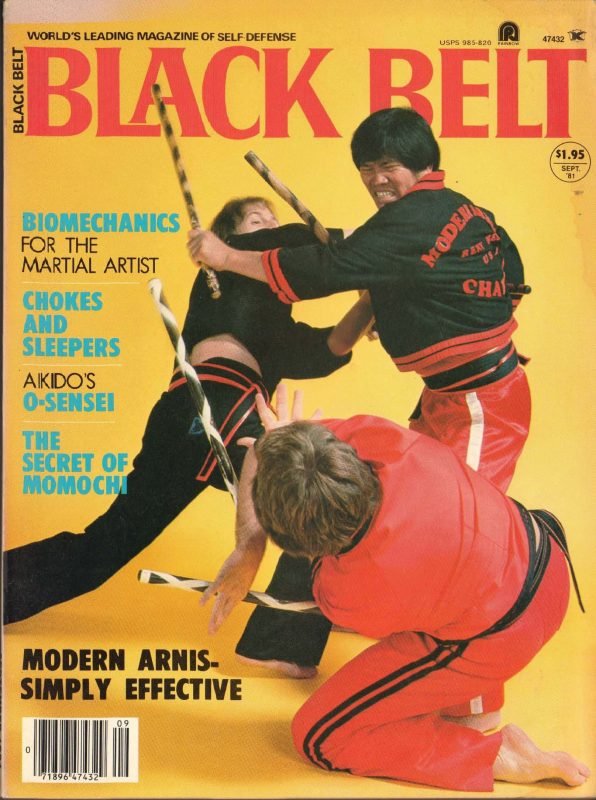
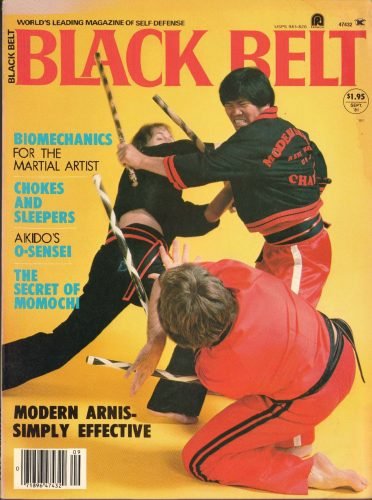
Remy Presas, founder of Modern Arnis.
It was in the US that he met other martial artists who influenced his development of the art of Modern Arnis. These included Wally Jay (Judo, Jujitsu), George Dillman (Ryukyu Kempo Karate). Remy learned much from his peers and adapted Arnis accordingly, integrating what he had picked up. However, he always retained a focus on the single stick and general self-defense.
Remy Presas died in 2001. Following his death, there was a splintering of the remaining leadership of Modern Arnis. With several rival factions emerging with their versions of Arnis. Regardless, the art of Modern Arnis continues to develop and is very popular both at home and worldwide.
Surge in Popularity: Arnis in Pop Culture and Hollywood
Filipino Martial Arts (FMA) has gained global recognition, thanks in part to its influence on cinema, action choreography, and modern martial arts systems. The first major breakthrough came through Dan Inosanto, a key figure in promoting Southeast Asian martial arts, including Pencak Silat and Eskrima, to Western audiences.
Inosanto, a friend and student of Bruce Lee, played a significant role in introducing Filipino martial arts into mainstream martial culture. Bruce Lee’s Jeet Kune Do (JKD) absorbed many FMA concepts, aligning with Lee’s philosophy of taking what is useful from all martial arts. Inosanto himself appeared in several martial arts films, further exposing audiences to Arnis’ fast, close-quarters combat style.



FMA helped get a big push from martial arts legends Daniel Inosanto (left) and Bruce Lee (right). Inosanto studied many of the obscure Southeast Asian martial arts such as Escrima and Silat. Bruce Lee would go on from becoming a screen legend to incorporating elements of FMA into his own martial arts system, Jeet Kune Do.
Over the years, Arnis continued to grow in popularity, with Hollywood directors favoring its brutal efficiency for fight scenes. Films like The Bourne Identity (2002) showcased a Kali-style knife fight, while Taken (2008) featured Liam Neeson using Arnis and Silat to dismantle his enemies. The Kick-Ass (2010) franchise further popularized Filipino weapons, with the protagonist wielding Escrima batons and Hit-Girl showcasing balisong knife techniques.
With its dynamic movement, realistic fight sequences, and raw effectiveness, Arnis has cemented itself as a staple of modern action choreography, making it more popular and accessible worldwide than ever before.

Arnis on the silver screen. Scenes from the film The Bourne Supremacy starring Matt Damon. FMA featuring in films helped raise the profile of Arnis internationally.


Arnis on the silver screen. Scenes from the films The Bourne Supremacy (left) starring Matt Damon, and Taken (right) with Liam Neeson. Both films helped raise the profile of Arnis internationally.
In recent years, there has been increased interest in Arnis for its usefulness when defending against knives in street encounters. Modern Arnis training methods stress direct, lethal tactics designed to instantly end encounters.
Organisation
After decades of lobbying, Arnis was officially declared the National Martial Art and Sport of the Philippines in January 2010. This long-overdue recognition cemented its status as a key part of Filipino heritage and culture.
There are two primary systems of Arnis practiced as a sport:
- WEKAF (World Eskrima Kali Arnis Federation) – Established in 1989, this is the most widely used international system, governing Arnis competitions globally.
- ARPI (Arnis Philippines) – Founded in 1986, this system gained prominence during the 2005 Southeast Asian Games.
Arnis has grown significantly outside the Philippines, with strong followings in the US, UK, Canada, and Germany, where numerous schools and organizations promote its practice. However, Arnis continues to expand worldwide, gaining recognition in many other countries as both a combat system and competitive sport.
Training
Arnis is highly diverse, with numerous styles originating from different regions of the Philippines. Despite their variations, all Arnis systems share universal principles, emphasizing weapons-based combat, seamless transitions to unarmed techniques, and a highly adaptable approach to self-defense.
Unlike many traditional martial arts that teach weapons only at advanced levels, Arnis starts with weapons from day one. This reverses the conventional training approach, where practitioners are typically taught empty-hand combat first. Arnisadores believe that armed and unarmed techniques are inherently linked, training both simultaneously to ensure a fluid transition between the two in real combat.
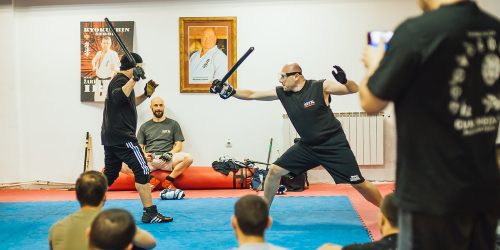
Weapons as an Extension of the Body
One of the defining characteristics of Arnis is its weapons-first training philosophy, a stark contrast to many martial arts where weapons are introduced only at advanced levels. In Arnis, armed and unarmed combat are trained simultaneously, based on the belief that striking with a weapon follows the same principles as striking with bare hands. Weapons are seen as an extension of the body, and the same footwork, angles, and mechanics apply regardless of whether a fighter is armed or unarmed.
Pragmatism in Combat
A key focus in training is the seamless transition from weapons to empty hands. In real fights, a weapon may be lost, disarmed, or unavailable, forcing the fighter to improvise or rely on bare-hand techniques. Arnisadores are trained to adapt instantly, maintaining their offensive and defensive structure whether armed or unarmed.
If a weapon is available, it is used. If not, the fight continues. The goal is to neutralize an opponent efficiently, using every advantage, object, and opportunity at hand. This pragmatic mindset makes Arnis one of the most adaptable and effective martial arts for real-world combat, where survival takes priority, and no quarter is given.

Knife Culture
The Philippines has always been a blade-oriented culture, with tribal warriors historically entering battle armed with bladed weapons, only resorting to unarmed combat if disarmed. Stick training was primarily introduced as a way to disguise blade training under Spanish colonial rule, using sticks in ritual dances to avoid detection.
Today, sticks remain the primary training tool, allowing Arnisadores to practice full-speed techniques safely while preserving real-world effectiveness. However, knife and sword training remain a core component of FMA, reflecting the practical realities of Filipino combat traditions.
The Weapons of FMA
Impact weapons
Click on the links below for more.
The primary weapon in Arnis is the baston (baton), also known as olisi or yantok. Typically around 28 inches (71 cm) in length, the baston comes in various sizes and is most commonly made from rattan—a lightweight yet highly durable Southeast Asian vine. Unlike wood, rattan does not splinter, making it safer for training, even under heavy impact. Its flexibility and resistance to shattering also make it an effective tool for defending against blades.
Arnis teaches both single and double stick techniques, with a stronger emphasis on the former. The curriculum also includes unarmed defenses against both sticks and bladed weapons, reinforcing adaptability in combat. In modern practice, Arnisadores often wear protective gear for the head and hands during sparring, and padded bastons are sometimes used to minimize injuries while maintaining the intensity of live training.

Doble Baston, also called Doble Olisi, refers to fighting with two sticks, a method that offers greater offensive versatility but requires considerable skill and coordination. In Arnis circles, double baston drills and techniques are collectively known as Sinawali, meaning “to weave” in Tagalog. The term originates from sawali, a woven matting used in traditional Nipa huts in the Philippines, reflecting the intricate, interwoven movements of the technique.
Mastering Sinawali demands equal proficiency in both hands, requiring extensive coordination drills to develop ambidexterity and fluid motion. While some basic Sinawali patterns are taught early, serious training in double baston techniques typically begins at intermediate and advanced levels, as it is considered one of the most crucial skill sets in Arnis.
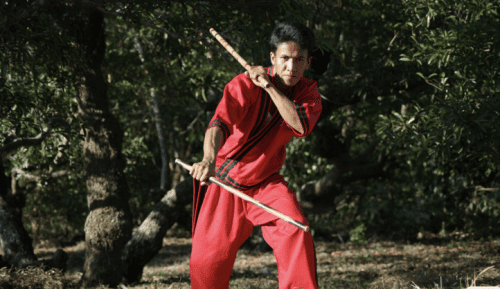
While the baston (olisi, yantok) is the most recognized weapon in Arnis, practitioners train with various impact weapons, including longer and shorter alternatives, as well as improvised tools.
- Baston (Olisi, Yantok) – A stick ranging from 24 to 28 inches, traditionally made of rattan.
- Largo Mano Yantok – A longer stick (28 to 36 inches), offering extended reach and heavier strikes.
- Dulo Dulo – A short stick (4 to 7 inches), held in the palm and used for striking pressure points and joint manipulation.
- Bankaw – A six-foot pole, often used in long-range combat and spear-based techniques.
- Improvised Weapons – Arnis emphasizes adaptability, using everyday objects as weapons, including wooden planks, steel pipes, umbrellas, flashlights, rolled-up newspapers, books, pool cues, bottles, chair legs, and even tree branches.
These weapons reinforce the core principles of Arnis, proving that combat effectiveness isn’t limited to traditional tools but extends to anything within reach.
Edged weapons
Arnis is deeply rooted in bladed weapon combat, with techniques adapted from both Filipino tribal warfare and Spanish fencing influences.
- Baraw (Cebuano) / Daga (Tagalog) – Both terms refer to knives or daggers, which can be wielded in single or double configurations.
- Espada y Daga – A long blade and short blade combination, using the sword for offense and the dagger for trapping or countering attacks.
- Olisi Baraw – A stick and dagger pairing, blending impact and edged weapon tactics.
Click on the links below for types of blades in Arnis.
Arnis incorporates a wide range of traditional Filipino bladed weapons, including:
- Daga / Cuchillo – Various daggers and knives.
- Balisong – The famous butterfly knife, with a folding two-piece handle.
- Karambit – A claw-shaped blade with a finger ring for control.
- Bolo – A machete-like blade, used for both combat and agriculture.
- Pinuti – A longer sword from Cebu, similar to the Sundang.
- Iták / Sundang – A farm tool often repurposed as a weapon.
- Barong – A wide, leaf-shaped blade, commonly used in Mindanao.
- Binakoko – A long blade named after a fish.
- Dinahong Palay – A narrow blade, shaped like a rice leaf.
- Kalis / Kris – A wavy-bladed dagger, most common in southern regions.
- Kampilan – A long, fork-tipped sword, used historically by warriors in Mindanao.
- Sibat – A Filipino spear, effective in both thrusting and throwing techniques.

Arnis teaches adaptability, making use of everyday objects as weapons in self-defense. Common improvised blades include:
- Ice picks, box cutters, screwdrivers, scissors, broken bottles, pens, and car keys (used in a push-dagger grip).
Training in edged weapons within Arnis follows the same principles as stick-fighting, but with added emphasis on lethal targeting, defensive positioning, and precision cutting techniques. Mastery of bladed combat is a critical component of advanced Arnis training, reinforcing its legacy as a battlefield-proven martial art.
Flexible weapons
Though not as widely practiced as stick and blade combat, flexible weapons are part of Arnis training, offering versatility in locking, tying, choking, and strangling techniques. These weapons allow for greater control over an opponent and can be disguised as everyday items, making them effective in self-defense situations.
Click on the links below for more.
- Sarong – A length of fabric worn like a belt, used for tying up limbs, choking, or weapon disarming.
- Ekut – A handkerchief, which can be used for distraction, blinding an opponent, or joint control.
- Tabak-Toyok – A rice flail (commonly known as nunchaku), effective in rapid strikes, entangling weapons, or limb control.
- Latigo – A whip, primarily used for long-range attacks, entanglements, or creating space against an opponent.
Arnis emphasizes adaptability, teaching the use of common objects as makeshift flexible weapons, including:
- Belts, bandanas, handkerchiefs, shirts, towels, socks with hard soap bars/rocks, ropes, power cables, and similar items.
While flexible weapons require greater skill and control, they add an extra layer of unpredictability to combat, reinforcing Arnis’ principle of using whatever is available in a fight.
Mano Mano (Empty Hand Combat)


Mano Mano, meaning “hand-to-hand” in Spanish, is the empty-hand component of Arnis, incorporating kicking, punching, joint locks, throws, and grappling. Unlike martial arts that separate armed and unarmed techniques, Arnis treats empty-hand combat as an extension of weapon training. Every movement in Mano Mano is directly based on weapons techniques, reinforcing the seamless transition from armed to unarmed combat.
Since Arnis emphasizes weapon proficiency first, Mano Mano is often taught at higher levels, with advanced students expected to apply their weapon experience to empty-hand fighting. This philosophy ensures that even without a weapon, an Arnisador remains highly effective in self-defense and combat.


Click on the links below for more.
Unlike high kicks in other martial arts, Arnis kicks focus on efficiency, power, and maximum damage. The goal is to inflict pain, break bones, or dislocate joints by targeting vulnerable areas such as the groin, thighs, knees, shins, ankles, feet, and toes. Common kicks and lower-body strikes include:
- Heel smashes – Driving the heel into joints or soft tissue to disable movement.
- Low-line kicks – Quick, devastating strikes aimed at the legs.
- Toe kicks – Precise attacks targeting pressure points.
- Trips and sweeps – Used to destabilize opponents and set up finishing strikes.
- Stomps and knee attacks – Designed to break or disable an opponent’s structure.
Because Arnis is rooted in real-world combat, its kicks prioritize practicality over flash, aiming to cripple opponents quickly and decisively.
One of the most defining principles of Arnis is the “live hand”, referring to the non-weapon hand used to trap, lock, support weapon blocks, check, disarm, strike, or control an opponent.
A live hand can be unarmed or holding a companion weapon, such as a dagger (Daga) in Espada y Daga techniques. Unlike styles that focus solely on the weapon-wielding hand, Arnisadores train to use both hands simultaneously, ensuring maximum control and efficiency in combat.
By integrating the live hand, Arnis enhances defensive and offensive strategies, making it a complete combat system that blends weapons, striking, and grappling into one fluid approach.

Important Concepts
Arnis is more than just a collection of techniques—it is built on key principles that define its approach to combat. These concepts ensure that practitioners can adapt to different situations, control engagements, and maximize efficiency in both armed and unarmed encounters.
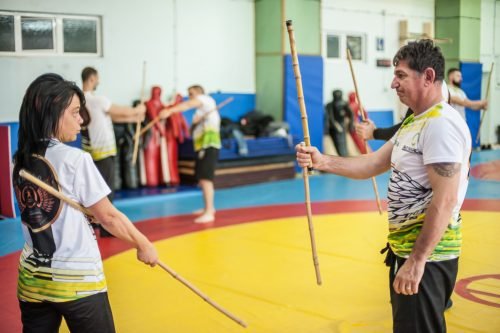
Click on the links below for important concepts in FMA.
The nature of combat changes depending on distance, and controlling the range of a fight is a fundamental skill in Arnis. The three main ranges are:
- Largo (Long Range) – Attacking with extended strikes, typically using long weapons like bastons or bankaws.
- Medio (Medium Range) – Closer engagement where checking, blocking, and trapping techniques are used.
- Corto (Close Range) – Hand-to-hand combat, including grappling, joint locks, disarms, and Mano Mano techniques.
Arnisadores drill footwork constantly to ensure they can dictate range and reposition effectively in combat.
Arnis techniques are designed to be simple, efficient, and instinctive. Attacks are categorized by angles rather than specific strikes, meaning that the same defensive movements apply regardless of the weapon used.
Repetitive drills improve speed, reflexes, and muscle memory, conditioning the body to react instinctively. This method gives Arnisadores confidence and automatic responses in combat situations.
Rather than training against specific attacks, Arnis focuses on defending against angles. Nearly all weapon and empty-hand strikes follow predictable paths, so training revolves around 12 angles of attack.
The 12 Angles of Attack
1-2: Lateral strikes to the head and neck.
3-4: Diagonal or horizontal strikes to the shoulders, elbows, and hands.
5: Midline thrust to the torso.
6-7: Strikes to the armpits or chest.
8-9: Strikes targeting the hips, knees, shins, or feet.
10-11: Lateral strikes aimed at the neck or eyes.
12: A direct downward strike from above.
The “1-12 Drill“ is a core training method, beginning with pre-arranged sequences before progressing to randomized attack patterns, requiring Arnisadores to react in real time.
Arnisadores learn to read an opponent’s body movements, syncing their rhythm to attack and defend effortlessly. By observing subtle cues from the shoulders and hips, they anticipate strikes and counter before the opponent can react.
Mastering timing and flow is a long-term skill but is essential for dominating engagements and countering attacks efficiently.
Arnis assumes that any opponent is dangerous and well-trained. Whether in sparring or real combat, the mentality is to expect danger and respond decisively. Practitioners are taught that in a fight, survival takes precedence—there is no room for hesitation.
Arnis prioritizes speed, power, and minimal wasted movement. Unlike traditional arts that use circular, extended strikes, Arnis attacks follow the shortest, most direct path.
- No telegraphing – Attacks are delivered without warning to prevent an opponent from reacting.
- Maximum damage, minimal effort – Strikes are designed to disable opponents quickly while conserving energy.
This efficiency makes Arnis particularly effective in real-world combat scenarios.
A key concept in bladed combat is “defanging the snake”—rather than blocking an attack, strike the opponent’s weapon hand to neutralize the threat instantly.
- Against knives or sticks, this means breaking the hand, severing tendons, or disabling the limb.
- Arnis also emphasizes targeting vulnerable areas, such as the eyes, throat, groin, and legs, to incapacitate an opponent as fast as possible.
This philosophy makes Arnis highly practical for self-defense, as it teaches brutal, efficient methods to eliminate threats.
Training in Arnis is designed to be fast and intense. Beginners start with practice weapons, but as they progress, training speeds up, forcing them to react instinctively and refine their skills under pressure.
Sparring sessions can be blindingly fast, requiring practitioners to develop razor-sharp reflexes. Over time, Mano Mano (unarmed combat) is introduced, ensuring that an Arnisador can seamlessly transition from weapons to empty-hand fighting.
Arnis is a battlefield-tested martial art built on practicality, adaptability, and efficiency. By training in range control, striking angles, timing, and movement economy, practitioners develop a highly effective and instinctive combat system. Whether armed or unarmed, the core principles of Arnis ensure that fighters are always prepared for real-world encounters.
Health and Fitness Benefits
Beyond its effectiveness as a combat system, Arnis offers numerous physical and mental benefits, improving strength, endurance, coordination, and overall well-being. The dynamic nature of training ensures a full-body workout, while the discipline and skill development provide long-term psychological rewards.
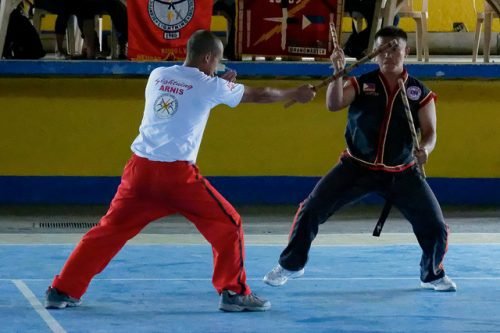
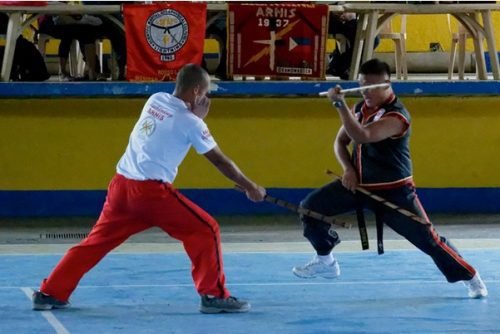
Escrima drills and sparring can provide an excellent full body workout.
Click on the links below for more.
Arnis is highly aerobic, with classes lasting up to two hours and varying in intensity from moderate to extremely strenuous. The footwork, striking drills, and sparring demand sustained cardiovascular effort, building endurance over time.
- Double Baston practice is particularly challenging, pushing both heart and lung capacity.
- Sparring with protective armor increases resistance, with matches lasting 2-3 minutes and minimal rest between rounds, testing both aerobic and muscular endurance.
Regular training improves stamina, recovery rate, and overall cardiovascular fitness.
Weapons-based training in Arnis strengthens the wrists, forearms, and hands, conditioning muscles and ligaments to withstand stress over time.
- Developing good grip strength is essential—not just for weapon retention in combat, but for everyday tasks like lifting and carrying objects.
- Strong wrists can also help prevent issues like carpal tunnel syndrome, making Arnis a great way to build injury resilience.
- The footwork and movement patterns stimulate the lower body joints, promoting flexibility and stability.
While not a conventional resistance workout, Arnis builds functional strength by engaging multiple muscle groups.
- Baston drills and sparring work both agonist and antagonist muscles, including flexors, extensors, adductors, abductors, and rotators.
- The shoulder girdle benefits greatly from flowing circular strikes and figure-eight patterns, reducing injury risk and improving mobility.
- Footwork training activates the core, hips, and lower body, improving balance and agility.
Though the resistance may not be as intense as weight training, Arnis complements strength workouts, targeting hard-to-reach muscle groups through its multi-angle striking system.
Arnis requires rapid, precise movements, developing exceptional hand-eye coordination. The speed of attacks and counters forces practitioners to think fast and react instinctively.
- Drills begin at a controlled pace and progress to high-speed reaction training, sharpening reflexes and decision-making.
- If you’re slow at first, pain will speed up your reactions—the occasional hit teaches you quickly.
Over time, anticipation and counterattacks become second nature, enhancing reaction speed in combat and everyday life.
Like all martial arts, Arnis requires dedication, repetition, and patience. Mastery doesn’t happen overnight—it demands:
- Consistency and effort to refine techniques.
- Mental focus and self-discipline, which translate into everyday life.
Training in Arnis fosters mental resilience, improving a person’s ability to stay calm under pressure and act decisively.
Arnis is a community-driven martial art, offering the chance to meet and train with people from all backgrounds.
- Sparring creates healthy competition, making training fun and engaging.
- Many Arnis schools emphasize respect and family values, building a strong sense of belonging.
Exercise is scientifically proven to boost endorphins, reducing stress and anxiety while promoting mental well-being.
- Arnis provides a confidence boost, knowing you have the ability to defend yourself if necessary.
- The combination of physical challenge and mental focus improves self-discipline, problem-solving, and self-assurance.
Regular training sharpens both body and mind, proving that Arnis isn’t just a martial art—it’s a path to greater health, fitness, and mental strength.
Conclusion
Arnis comes from a blood-soaked history, forged through conflict with the Spanish, Japanese, and Americans, each of whom learned firsthand the lethal effectiveness of Filipino martial culture. What began as a battle-tested art of survival has evolved into one of the world’s most adaptable and formidable fighting systems—a legacy that continues to thrive today.
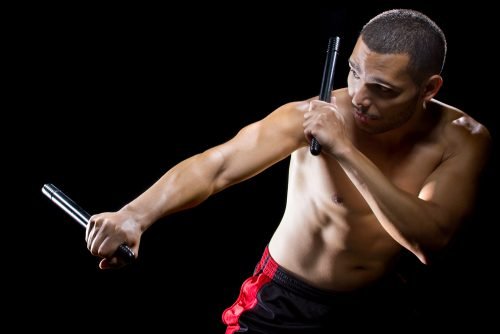
Beyond combat, Arnis delivers immense training benefits, improving cardiovascular endurance, functional strength, joint mobility, reaction speed, power, and overall athleticism. Its fluid movement, unpredictable striking angles, and seamless integration of weapons and empty-hand techniques make it a highly dynamic and difficult-to-counter martial art.
So, is Arnis for you? Whether you’re a seasoned martial artist, an athlete seeking a new challenge, or simply looking for something unique, Filipino Martial Arts is more accessible than ever. With its rich history, practical self-defense applications, and intense physical training, Arnis might just be the missing piece in your martial journey.
If you have enjoyed this post please share or feel free to comment below 
Related Posts
Our Other Posts
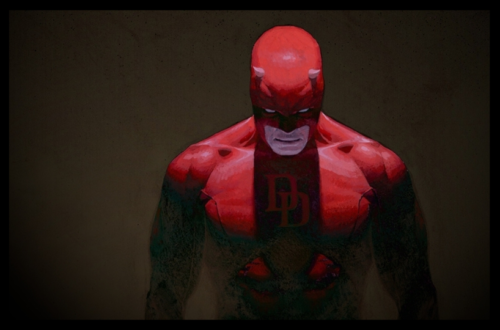
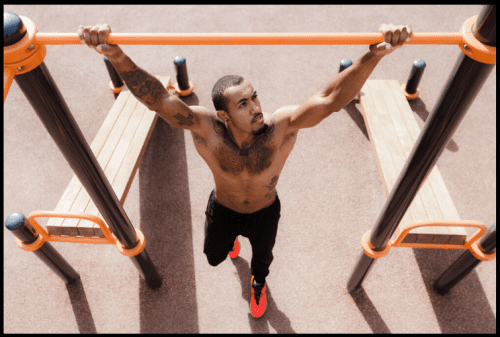
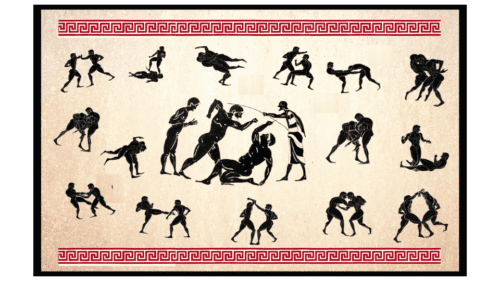
Ancient Pankration – Combat Sport of Ancient Greece
Pankration was an Ancient Greek no-holds-barred martial art combining aspects of boxing and wrestling, introduced


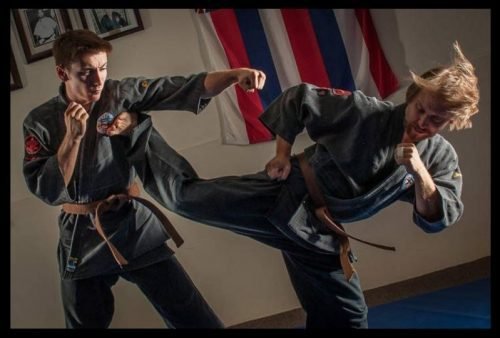
Kajukenbo – Born in Battle, Rooted in Tradition
Kajukenbo, the hybrid martial art born in post-war Hawaii. Built for real-world survival, it combines

